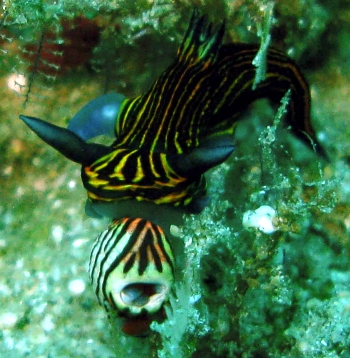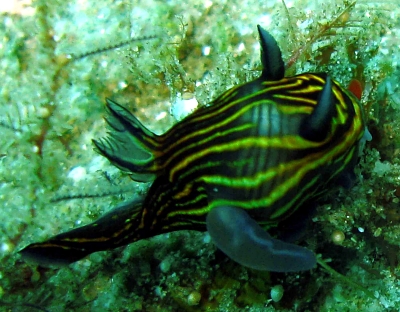Nembrotha aurea being eaten by Robostra luteolineata [1]
April 15, 2008
From: Colin Ogden


Concerning message #21419:
Hi Bill,
I had a fascinating experience on a dive today. I came across these two nudibranchs about 10 cm apart. The predator (which I think is a Roboastra luteolineata or maybe a Tambja zulu) was moving very fast, and on the photo you can see it is actually preparing its mouth for a meal. The Nembrotha aurea was totally unaware of the threat. As the Roboastra approached within 2 cm the Nembrotha sensed his presence and tried to swim away without success. The Roboastra then caught the Nembrotha who immediately retracted his gills. Also the Robastra is obviously very aroused as it has its sexual organs fully extended. The Roboastra then swallowed the Nembrotha and the entire process took just over 3 minutes. The final photos are of the Roboastra moving off very sluggish and swollen after his meal. I found this quite an emotional experience, as the N. aurea has just been described, and followed my recent message when I found two mating - "Creation and destruction in 2 days"
Locality: Sodwana Bay, 22 metres, South Africa, Indian, 13 April 2008, reef. Length: 35mm & 20mm. Photographer: Colin Ogden.
[see message #21527 for full series of photos]
Regards
Colin
scubaco@iafrica.com
Ogden C. M., 2008 (Apr 15) Nembrotha aurea being eaten by Robostra luteolineata [1]. [Message in] Sea Slug Forum. Australian Museum, Sydney. Available from http://www.seaslugforum.net/find/21526
Dear Colin,
Thanks for this fascinating series of photos. Although all nudibranchs are carnivores, it's interesting how we think of hunters which eat large moving prey, such as species of Roboastra and Gymnodoris, in a different way to the majority of nudibranchs that feed on 'plant-like' animals such as hydroids, bryozoans and sponges. It always seems more 'primal'.
The 'hunter' is identified here as R. lutolineata [see #4639] even though South African examples lack the green patches on the head which are found in specimens from the western Pacific. It ceratinly has similalrities in colour to Tambja zulu, but apart from anatomical differences, species of Tambja feed on bryozoans
Best wishes,
Bill Rudman
Related messages
-
Nembrotha aurea being eaten by Robostra luteolineata [2]
From: Colin Ogden, April 15, 2008 -
Re: Nembrotha rutilans, N. aurea & N. purpureolineata
From: Colin Ogden, April 15, 2008 -
Nembrotha rutilans, N. aurea & N. purpureolineata
From: Bill Rudman, March 4, 2008 -
Nembrotha purpureolineata - juvenile
From: Wyatt Ang, July 13, 2007 -
Nembrotha purpureolinata - feeding?
From: Colin Ogden, March 29, 2006 -
Nembrotha purpureolineata mating
From: Roberto Sozzani, May 4, 2005 -
Nembrotha purpureolineata from Mozambique
From: Charles Rowe, February 7, 2005 -
Nembrotha purpureolineata on an unusual path
From: Valda Fraser, August 15, 2003 -
Nembrotha purpureolineata from Indonesia
From: Jim Bartlett, November 28, 2002 -
Nembrotha purpureolineata feeding?
From: Scott Johnson, October 25, 2002 -
Nembrotha purpureolineata from Komodo
From: Walabha Sinbul, August 7, 2002 -
Nembrotha purpureolineata from Japan
From: Yasuhiro Shirai, May 30, 2002 -
Nembrotha purpureolineata? from Sulawesi
From: Mary Jane Adams, May 11, 2002 -
Nembrotha? from Japan
From: Ken-Ichi Ohno, May 10, 2002 -
Nembrotha purpureolineata from Westn Australia
From: Kirk Gibson, April 1, 2001 -
Nudibranchs of Southern Africa
From: Yvonne Rozsenich, February 10, 2001 -
Mating Activity - Nembrotha rutilans
From: Ken Knezick, January 18, 2001 -
Nembrotha from Philippines
From: Erwin Koehler, March 14, 2000 -
Nembrotha purpureolineata from South Africa
From: Valda Fraser, December 20, 1999
